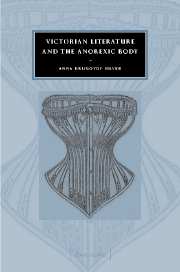Book contents
- Frontmatter
- Contents
- Acknowledgments
- Introduction
- 1 Waisted women: reading Victorian slenderness
- 2 Appetite in Victorian children's literature
- 3 Hunger and repression in Shirley and Villette
- 4 Vampirism and the anorexic paradigm
- 5 Christina Rossetti's sacred hunger
- Conclusion: the politics of thinness
- Notes
- Bibliography
- Index
- CAMBRIDGE STUDIES IN NINETEENTH-CENTURY LITERATURE AND CULTURE
2 - Appetite in Victorian children's literature
Published online by Cambridge University Press: 22 September 2009
- Frontmatter
- Contents
- Acknowledgments
- Introduction
- 1 Waisted women: reading Victorian slenderness
- 2 Appetite in Victorian children's literature
- 3 Hunger and repression in Shirley and Villette
- 4 Vampirism and the anorexic paradigm
- 5 Christina Rossetti's sacred hunger
- Conclusion: the politics of thinness
- Notes
- Bibliography
- Index
- CAMBRIDGE STUDIES IN NINETEENTH-CENTURY LITERATURE AND CULTURE
Summary
It is perhaps unsurprising that Victorian fashion magazines and beauty manuals emphasize the importance of beauty in a woman's life, since they were in the very business that they relentlessly promoted. The authors of books such as The Science of Dress or The Art of Beauty, and the editors of magazines like La Mode Illustrée depended upon women's continued concern over appearance in order to sell their products, and in turn, they reinforced this concern by rearticulating particular ideas of gender and the female body for their readers. Ideologies of body image in literature, on the other hand, are far less overt than in texts that explicitly attempt to convince women to wear particular kinds of dresses or corsets. Nevertheless, the same ideologies that are discernable in non-literary texts – such as the idea that a woman's sexual purity is coded by her body shape – appear in the work of many canonical and non-canonical Victorian authors. Victorian children's literature is a particularly good place to look for evidence of the beginnings of a culture of anorexia within a self-consciously literary discourse because, as children's literature critic Peter Hunt has written: “All books must teach something, and because the checks and balances available to the mature reader are missing in the child reader, the children's writer often feels obliged to supply them.”
- Type
- Chapter
- Information
- Victorian Literature and the Anorexic Body , pp. 51 - 80Publisher: Cambridge University PressPrint publication year: 2002



